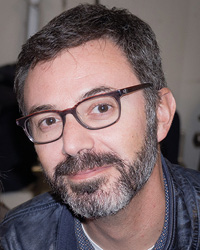Claudio Nidasio interviews Paolo Bosetti.
The new laboratories of the ProM Facility - where ProM stands for Prototyping of Mechatronics – are the fruit of a collaboration between the Autonomous Province of Trento, Trentino Sviluppo (the province’s business development agency), the University of Trento, Fondazione Bruno Kessler (FBK) and Confindustria Trento, and offer companies in the mechatronics sector an integrated plaform for the design, development, production, verification and validation of production systems and processes. An important element has been added to the Mechatronics Hub in Rovereto.
We talked to Paolo Bosetti, associate professor in the Department of Industrial Engineering at the University of Trento and scientific director of the ProM Facility.
Professor Bosetti, the ProM Facility aims to reduce the time necessary for the development and production of industrial artefacts and prototypes through cutting-edge machinery. What equipment is available to companies?
 The ProM Facility will make equipment and machinery available for four lines of work: prototyping, testing, metrology and ICT. For prototyping it will be possible to produce components through 3D printing (in metal, in polymer and in composite), laser-cut sheet metal and tubes, and mechanical components through machining and through electrical discharge machining, as well as to build circuit boards. Testing of prototypes will be possible using test benches for mechanical testing and for motor testing, and a climatic test chamber with a shaker. Metrology both allows the dimensions and geometry ot the prototyped components to be verified and enables reverse engineering operations to be performed, via laser scanning, tomography x-ray, interferometry and touch-trigger probes. Finally, the ICT line of work provides support for the development of IoT (Internet of Things) and artificial intelligence solutions to integrate into mechantronic products. Thanks to financial support from the Caritro Foundation, the facility will be equipped with a cutting edge supercomputer for training Deep Neural Networks, which are very important in the field of artificial intelligence.
The ProM Facility will make equipment and machinery available for four lines of work: prototyping, testing, metrology and ICT. For prototyping it will be possible to produce components through 3D printing (in metal, in polymer and in composite), laser-cut sheet metal and tubes, and mechanical components through machining and through electrical discharge machining, as well as to build circuit boards. Testing of prototypes will be possible using test benches for mechanical testing and for motor testing, and a climatic test chamber with a shaker. Metrology both allows the dimensions and geometry ot the prototyped components to be verified and enables reverse engineering operations to be performed, via laser scanning, tomography x-ray, interferometry and touch-trigger probes. Finally, the ICT line of work provides support for the development of IoT (Internet of Things) and artificial intelligence solutions to integrate into mechantronic products. Thanks to financial support from the Caritro Foundation, the facility will be equipped with a cutting edge supercomputer for training Deep Neural Networks, which are very important in the field of artificial intelligence.
The University of Trento is one of the parties involved in the ProM Facility, with some teaching, research and technology transfer activities taking place there as part of Industry 4.0. Can you tell us about the role of the University in supporting the ProM Facility?
The facility was designed and is run under a memorandum of understanding between the University of Trento, Trentino Sviluppo, Fondazione Bruno Kessler, and Confindustria Trento. The University (through a delegate) takes scientific responsibility for the activities. The University is responsible for coordinating the research and technology transfer activities within ProM, by providing support and an intellectual contribution to research and development projects conducted by companies at the facility, by teaching through doctoral programmes, theses and laboratory activities, and by providing training in the new technologies for professionals and those who work in industries in the region. By virtue of that contribution, researchers at the University have access to the equipment at the facility at a reduced rate, covering the cost of energy and consumables.
The ProM Facility was used to produce a single-seater electric car for the E-Agle Trento Racing team, made up of students from the University of Trento. What is this project about and how were the development and prototyping technologies used?
About a year ago our University set up its own racing team, consisting exclusively of students on bachelor’s and master’s degree courses, mainly in Engineering and Economics, to participate in the Formula SAE competitions. These are international competitions that started in the United States in the 1980s, and that in the last ten years or so have had a strong presence from Italian universities. Our team started work last September on the very first UniTrento single-seater and received an important contribution from the sponsorship of Trentino Sviluppo, which chose this single-seater car as a way of putting the ProM Facility to the test, in the production of an electric racing car. The car was completed in July of this year, with an innovative tubular chassis with 3D printed structural joints and laser-cut tubes. The students worked with great enthusiasm and dedication on this extremely ambitious project (to produce a racing car in under a year), working at the Facility and making full use of the machinery and the skills of the technicians. One of the team’s first results was to participate in the competition held from 19 to 23 July at the Riccardo Paletti Circuit in Varano de’ Melegari (Parma). The E-Agle Trento Racing Team won first place, with the single-seater Chimera, for the best telemetry solution, that is, the best system for the collection and communication of the operating data of all the systems of the vehicle. These data can be easily seen by the driver via a large display on the steering wheel, and by the technical team in the paddock.




